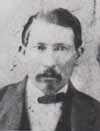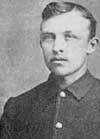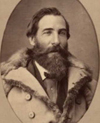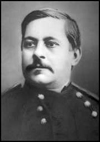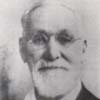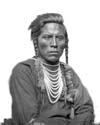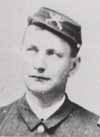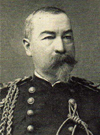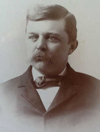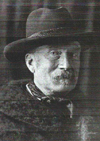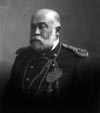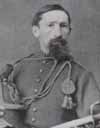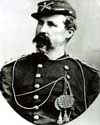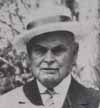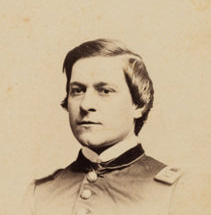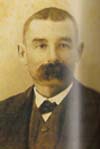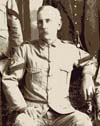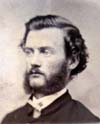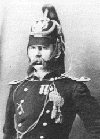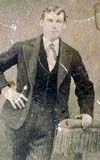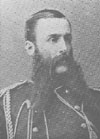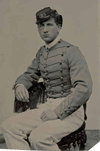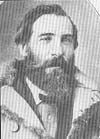Stanislas Roy (left) was born in France on November 12, 1846. He enlisted in the Seventh Cavalry in 1869 and served on both the Yellowstone and Black Hills expeditions. He later served as a corporal in Company A in the valley and hilltop fights at Little Bighorn. He was awarded the Medal of Honor for his actions during the battle.
William Sadler died of diabetes on November 12, 1921, in Bismarck, North Dakota, and was buried the following day in the Linton Cemetery in Linton, North Dakota. He was a Private in Company D. Despite what his obituary stated, he was at Powder River at the time of the battle and not with Reno’s command.
Patrick Coakley (left) died at the Soldiers’ Home in Washington, D.C., on November 13, 1881, and was buried in the National Cemetery there. He was a Private in Company K who was not present at the battle due to detached service as an orderly for General Terry.
Thomas H. Rush, who was also known as Thomas Morton, died on November 13, 1905, in Elmhurst, Alameda County, California. He was a Sergeant in Company D who was not present at the battle because he was hospitalized at Fort Abraham Lincoln, Dakota Territory.
William C. Slaper (left) died on November 13, 1931, in Sawtelle, California, and was buried in the Los Angeles National Cemetery. He was a Private in Company M who participated in the valley and hilltop fights. He attended the 50th Anniversary Reunion of the battle in 1926.
Frederic Francis Girard (left) was born on November 14, 1829, in St. Louis, St. Louis County, Missouri. He was an Interpreter on the Quartermaster staff who was missing during the valley fight on June 25. He rejoined the soldiers on Reno Hill on June 26.
Edward Rood (left) was born in Tioga County, New York, on November 14, 1847. He was a Private in Company E who was killed in the battle.
Marcus Albert Reno (right) was born on November 15, 1834, in Carrollton, Illinois. He commanded a battalion during the hilltop fight. Entire books have been written about Reno because he played a significant and controversial role in the battle.
Frank Volkenstine, who was also known as Frank Bowers, was born on November 15, 1844, in Birmingham, Michigan. He was a Private with Company M, but he was not on the campaign because he was dishonorably discharged in Fort Wayne, Michigan, on May 31, 1876.
On November 15, 1877, Frederic Francis Girard (above) married his second wife, Ella Scarborough Waddell. He had previously been married to a Piegan Indian.
Markus Weiss died on November 15, 1879, at Fort Meade in the Dakota Territory and was buried in the Fort Meade National Cemetery in Sturgis, South Dakota. He died of a compound fracture of his neck that resulted from a cave-in of a gravel bank. He was a Private in Company G who participated in the valley and hilltop fights. See also 7th Cavalry Troopers in South Dakota.
Benjamin Johnson Haverstick died on November 15, 1922, in Lancaster, Pennsylvania, and was buried there in the Greenwood Cemetery. He was a Private in Company G who participated in the valley and hilltop fights.
William David Nugent (left) died on November 15, 1934, in Coffeyville, Kansas, and was buried in the Parotte Cemetery in Cushing, Payne County, Oklahoma. He was a Private in Company A who participated in the valley and hilltop fights.
James J. Galvan, who was also known as Michael John Miller, was born in Liverpool, England, on November 16, 1848. He was a Private in Company L who was killed in the battle.
John Donahoe died of heart failure on November 16, 1905, in San Francisco, California, and was buried in the National Cemetery there. He was a Saddler for Company B and participated in the valley and hilltop fights.
Hugh McGonigle died on November 16, 1916, in Washington, D.C., and was buried at the Soldiers’ Home National Cemetery there. He was a Private in Company G who fought in the valley and hilltop fights.
Emil Taube (left) was born on November 18, 1847, in Damerau, Germany. He was a Private in Company K who was on detached service at Yellowstone Depot during the battle.
Frederick Henry Gehrmann was born in Baltimore, Maryland, on November 18, 1855. He was a Private in Company B who was on detached service at Yellowstone Depot during the battle.
Walter Scott Sterland married Ella Jane Blanchard on November 18, 1879. He was a Private in Company M who was on detached service at Yellowstone Depot during the battle.
James Hill died in Wooster, Ohio, on November 18, 1906, and was buried in the Wooster Cemetery two days later. He was the First Sergeant of Company B who was a pack train escort and fought on the hilltop.


